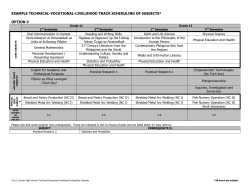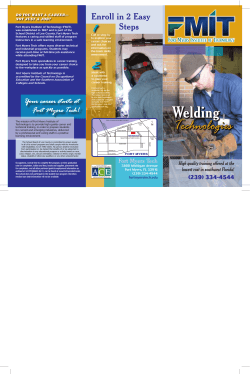
Ultrasonic Plastic Welding
Ultrasonic Plastic Welding Prepared and presented By: Dipal M.Patel 08PGME14 Guide By: Mr. A.U.Rajurkar Introduction A solid state welding process in which coalescence is produced at the faying surfaces by the application of high frequency vibratory energy while the work pieces are held together under moderately low static pressure. Ultrasonic welding, one of the most widely used welding methods for joining thermoplastics, uses ultrasonic energy at high frequencies (20 – 40 kHz) to produce low amplitude (1 – 25 µ m) mechanical vibrations. The vibrations generate heat at the joint interface of the parts being welded, resulting in melting of the thermoplastic materials and weld formation Lay-Out Of Ultrasonic Plastic Welding Machine Click to edit Master text styles Second level ● Third level ● Fourth level ● Fifth level Stages Of Ultrasonic Welding Introduction Of ABS Plastic ABS - Acrylonitrile Butadiene Styrene It is a copolymer made by polymerizing styrene and acrylonitrile in the presence of polybutadiene. The proportions can vary from 15 to 35% acrylonitrile, 5 to 30% butadiene and 40 to 60% styrene. The result is a long chain of polybutadiene criss-crossed with shorter chains of poly(styrene-co-acrylonitrile). For the majority of applications, ABS can be used between −25 and 60 °C as its mechanical properties vary with temperature. The properties are created by rubber toughening, where fine particles of elastomer are distributed throughout the rigid matrix. Properties Of ABS Plastic Pleasing Surface Density-1110 kg/m3 Good Chemical Resistance, Melt Temp (°C)- 211 to 261. Good Impact Resistance, Low Shrinkage Moisture Absorption Low Oil Resistant Good weld ability Good Corrosion Application of ABS Plastic Aerospace Applications Cell Phones Coating Applications Computer Components Containers Cookware, Microwave Kitchenware Prototyping Telecommunications Toys Video Equipment Camera Applications Automotive Bumper Automotive Exterior Parts Automotive Electronics Application Literature Review Process has had widespread industrial use in the last 25 year. Most of the earlier studies authored by investigators in the soviet union. Much of published literature on ultrasonic welding is qualitative , and it gives a good overview of ultrasonic welding and its application. Potente has studied various aspect of the process including the longitudinal response of part to imposed vibration. Benator studied theoretically and experimentally the ultrasonic welding of thermoplastic. Phase -1:-Design of Horn A welding horn, also known as a sonotrode, is an acoustical tool that transfers the mechanical vibrations to the work piece, and is custom-made to suit the requirements of the application. The traditional methods for the design of an acoustic horn are based on the equilibrium of an infinitesimal element under elastic action, inertia forces, and integration over the horn length to attain resonance . Equilibrium leads to the following differential equation: Design of horn Horns are designed as long resonant bars with a half wavelength. By changing the cross sectional shape of a horn, it is possible to give it a gain factor, increasing the amplitude of the vibration it receives from the transducer – booster combination. Three common horn designs are the step, exponential, and catenoidal, as shown in Fig. 2.9 . Step horns consist of two sections with different Design of horn Click to edit Master text styles Step horns consist of Second level two sections with ● Third level ● Fourth level different but uniform ● Fifth level cross-sectional areas. The transition between the sections is located near the nodal point. Due to the abrupt change in cross-section in the nodal plane, step horns have a very high stress concentration in this area and can fail if Design Of Horn Exponential horns have Click to edit Master text styles Second level a cross-sectional area ● Third level that changes ● Fourth level exponentially with ● Fifth level length. The smooth transition distributes the stress over a greater length, thus offering lower stress concentrations than that found in step horns. They generally have lower gain factors, so are used for applications Design Of Horn Click to edit Master text styles Catenoidal horns are Second level basically step horns with ● Third level ● Fourth level a more gradual transition ● Fifth level radius through the nodal point. They offer high gains with low stress concentrations. Design Of Horn Material For Horn Aluminium:Aluminium is a low-cost material which can be machined easily, and which has excellent acoustic properties. For these reasons, it is used for welding large parts and to make prototype horns or horns requiring complex machining. Aluminium may be inappropriate for long-term production applications due to its poor surface hardness and fatigue properties . Design Of Horn Titanium:Titanium has good surface hardness and fatigue strength and excellent acoustic properties. However, it is very expensive and difficult to machine. Titanium may also be carbide-coated for high wear applications. Steel:Steel horns can only be used for low amplitude applications due to its low fatigue strength. For severe wear applications such as ultrasonic metal inserting and welding glass filled materials, steel horns can be satisfactory. Phase-2:- Specimen Preparation Phase-3:-Experimentation According to different parameter various in the ultrasonic machine first of all consider pressure effect on weld strength of the joint. We will take reading at different pressure values and test the welding strength of the joint . In Second stage consider the time effect on the weld strength of the joint In that we change the time of welding and observe the welding strength of the joint. Here , we also optimize the horn design by varying different parameter. Phase-4:-Validation with FEA tools For any experimentation work carried out by anybody validation of that work is most important phase for the experimentation . Validation gives the proof of data and result , which is carried out from experimentation work. For above all mention work we validate that work with different FEA tools like, ANSYS 12.0 , Pro-engineering wildfire -4. Phase-5-Report Preparation Last phase for any dissertation work is report preparation. Relevant Work On Ultrasonic Plastic welding Ultrasonic welding is used in almost all major industries in which thermoplastic parts are assembled in high volumes. Some examples are as follows: Automotive: headlamp parts, dashboards, buttons and switches, fuel filters, fluid vessels, seat-belt locks, electronic key fobs, lamp assemblies, air ducts. Electronic and appliances: switches, sensors, data storage keys. Medical: filters, catheters, medical garments, masks. References 1. 2. 3. 4. 5. Troughton, M. J. “Handbook of plastics joining : a practical guide” / M.J. Troughton. -- 2nd ed. Ensminger D. and Stulen B. “Ultrasonic : Data, Equations, and Their Practical Uses” CRC press K.H.W. Seah, Y.S. Wong and L.C. Lee.“Design of tool holders for ultrasonic machining using FEM” Journal of Materials Processing Technology, 37 (1993) 801 816 Elsevier . S.G. Amin, M.H.M. Ahmed, H.A. Youssef* “Computer-aided design of acoustic horns for ultrasonic using finite-element analysis machining” . Journal of Materials Processing Technology 55 (1995) 254-260. www.powerultrasonics.com
© Copyright 2025










